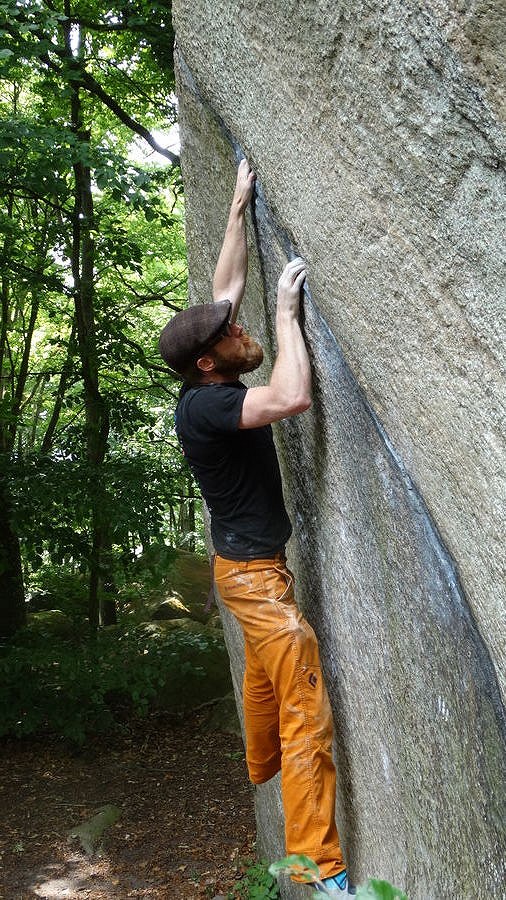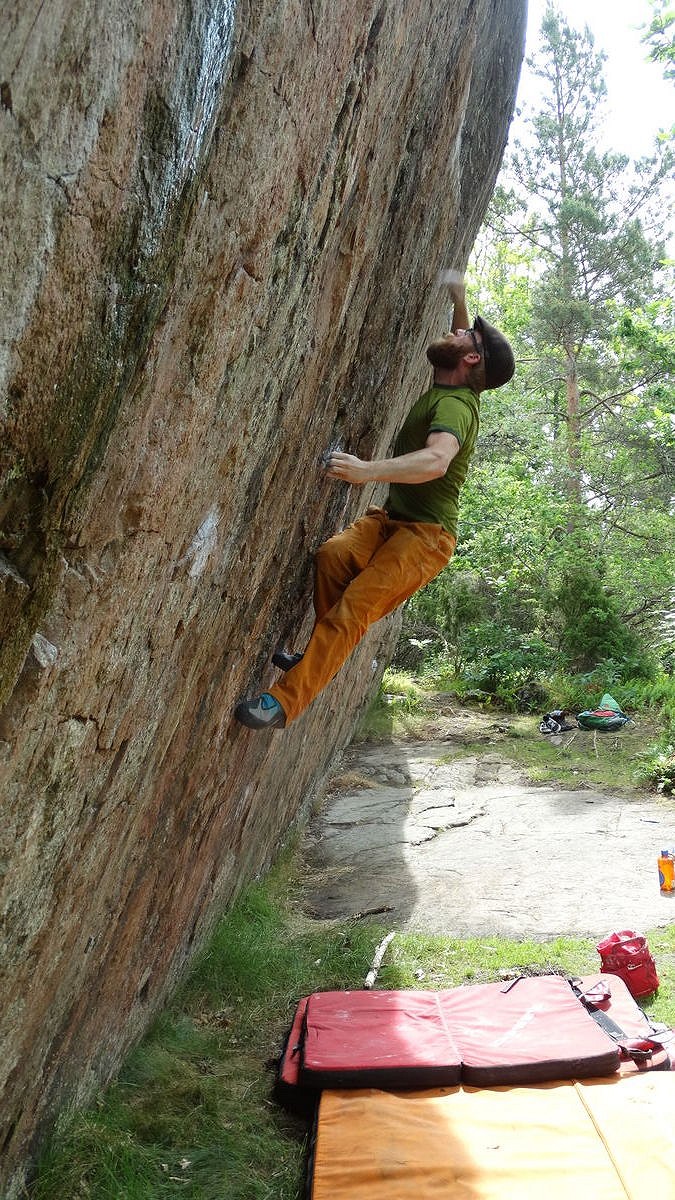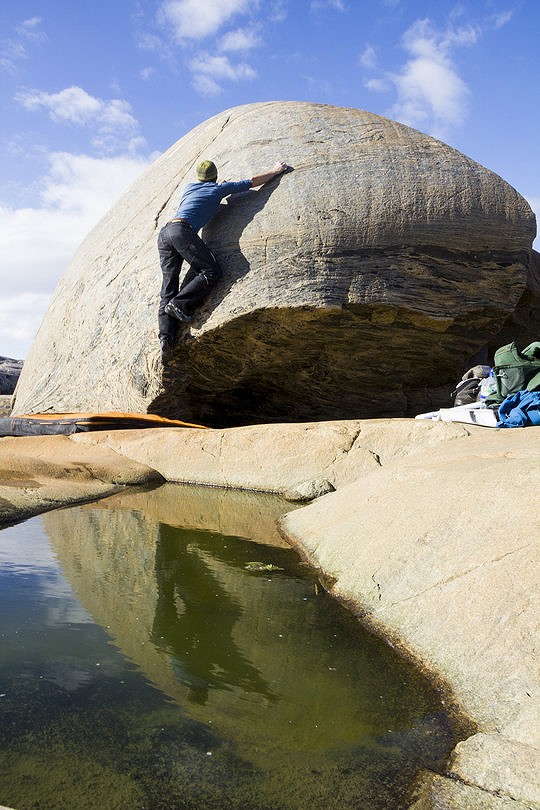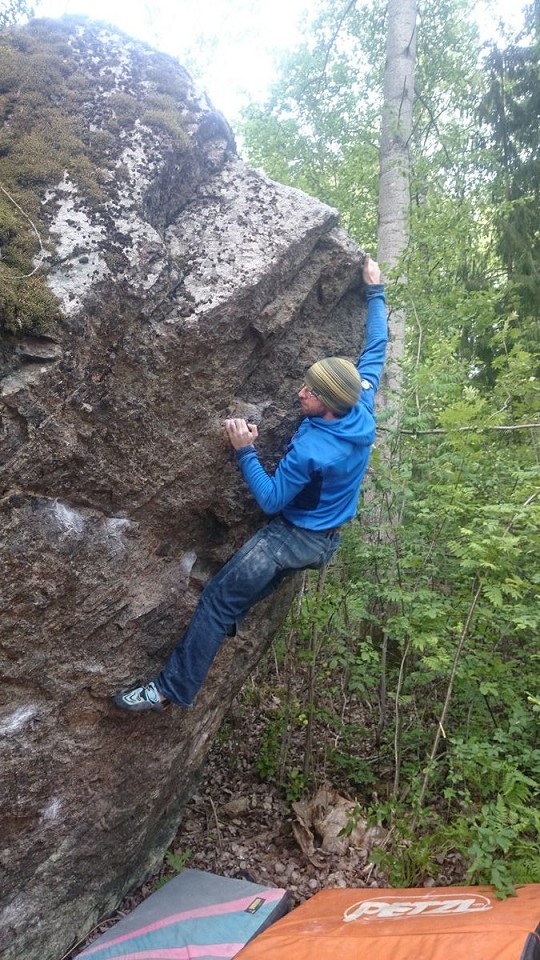
If you were to ask any dedicated boulderer about Europe's best spots, the answers you'd get would be pretty predictable: Fontainebleau, Magic Wood, Albarracin and so on. The reasons are obvious to anyone who's been there, or even those who've only read about them! But does that mean that there aren't many other places around the continent that can hold their own on the international stage?
For my annual summer trip, we opted to head to northern Europe, searching for cooler conditions, super long evenings and quality rock in one of Europe's slightly forgotten nations. We found it in abundance.
Since coming back, I've joked that any visiting climber could go and have their own crag and I'm not joking: there is so much unclimbed rock there, it's unreal. All along the east coast, there is crag after crag; most of which with granite never before touched by a human hand.
Our trip started, really, after a long drive from North Wales to Kobenhavn to collect my old friend and travelling companion, Simon; formerly of Vancouver, BC. After all, if you want to test the quality of granite boulders, a guy from Squamish is always going to be a good judge!
We'd previously been to Font (a couple of times) and Magic Wood so his experience would be valuable and we started at his "local" crag, a couple of hours east of Denmark's lowland countryside.
Kjugekull
Simon had been here several times before but it was a place that had eluded me. One of Sweden's more prominent crags, it's one that you may have heard of before. Hidden behind trees a few miles from the coast, in typical Swedish fashion, you'd easily sweep straight past it, if you didn't know it was there. Located near the town of Kristianstad, it's also one of the southernmost crags in the country; so June was probably not the best time to visit.
Perhaps we had been spoiled by some other fantastic places in the past but as we wandered around, it seemed there wasn't that much there; enough to keep us occupied for a weekend easily but possibly not for an entire week. A few days later, after obtaining an out-of-print guidebook, it dawned that this may have been a hasty judgement and even at the time, one couldn't deny the concentration of climbs in such a small area.
It actually transpired that Kjugekull houses a whopping 1100+ problems in a very small area indeed – a ten minute walk will take you from one end of the boulders right down to the other! Walk ins are short, landings are perfect and there is no way you could deny the outstanding lines such as the gorgeously inviting splitter crack, Monolith 7a+. Meanwhile, the striking Caspersens Arete 7b might be high enough for your knees to go weak at the sight of it, but it does have an incredible allure.

One criticism I stand by though is the rock quality. While the heat won't have helped, the granite did have a unique and unusual way about it that I have never experienced before. At first we thought it was polish, and you can't deny that in such a standout venue with little competition for miles around, the continual tramping of hands and feet will have had its effect, but it wasn't that. On closer inspection, we found granite made of large crystals that was smooth to touch.
Boulders found near oceans and seas can often have a washed over smoothness to them – it's the nature of millennia of geological change but it did detract from an otherwise excellent area.
Vastervik
A few hours to the North lies the wonder that is Vastervik. For everything that defines Kjugekull, this is something almost exactly the opposite. Based around a growing and busy city, the climbing is spread out much in the same fashion as Fontainebleau or the Peak District: dozens of isolated crags containing a handful of problems each.
We scratched the surface with two of them, Rödaväggen and Lysingsbadet, but there were so many more we could've stayed for a fortnight and not got round enough. It helped that we were based on the large coastal campsite (a village in itself really!) in a small hut, or stugar. In hindsight, our bunk room wasn't really necessary, as the campsite contains several large "lounges" with tables, chairs, cookers and sinks, as well as a TV for chilling in the evenings. Even when the weather turned on us, we were still comfy and cosy.
The campsite's name is also Lysingsbadet, suggesting, quite correctly, that the camping and climbing are right next to each other. Indeed, it wouldn't be surprising to find a group of kids running around the crag, on the adventure playground or shooting off down the massive aerial runway. Not that it would affect the climbing; while there is a crag developed including a handful of 3s and 4s, other areas exist for those climbing a bit harder. My personal choice would be to head to the Branton sector and check out Golem 7a+, Mister Miyagi 7a+ or ET 7a. Alternatively, the Centrum Blocken houses some excellent 5s and 6s, including Min Kamp på Kammen 6b – certainly worth a look, especially considering the ease of access!

Rödaväggen is a slightly different proposition, but certainly a recommended one! As with many crags in Sweden, it is found off the beaten track, hidden deep in the bush, after gravel tracks have led you from the main road. Navigation is not difficult and the walk in, as is often the case, is short. Once there, a striking red wall leans slightly off vertical towards you, the top bordering on highball but staying just low enough to avoid the fear of a fall, and the landing being as perfect as you could possibly ask for.
Most of the climbs sit in the high 6s and low 7s but there are grades for all here. What's more, a free photo topo can be found online at 27crags.com as is the case throughout Scandinavia. There is also a phone app available too.
Of course, this is merely two crags in a wide area with plenty more to go at. We both agreed that we would dearly like to return and explore; both leaving with more enthusiasm than we did when departing Kjugekull.
Uppsala
Further north still, around the Stockholm area, lies Sweden's fourth largest city, Uppsala. While this may not be saying much in terms of a small population of just under 130,000, it does lend the crucial factor critical to finding quality rock climbing: where you find people in this country, you will find climbing.
The east coast of the country is scattered from bottom to top with rock. Often while driving, we would glance off the road and see another green and unclean crag; nothing of any note, no established lines that we were aware of. I spoke to my friend Fredrik about this and his reply was pretty simple: "In Gävle, there's a climbing club, so there's development. In Sundsvall, there's a climbing club. In between, there's just no one there. There's plenty of rock, but no one there to develop it!"
So it's not really surprising to find that Uppsala/Stockholm has an extensive guidebook. There are tonnes of lines here, from inner city crags in the capital to more hidden gems in the middle of literally nowhere. I managed to see just a couple of crags, given the strict time constraints but the thing that instantly grabbed me at both venues was the outstanding rock quality – the granite truly was as good as I have seen anywhere in the world.
The lines at both Focksta and Källbergahygget struck me as excellent too, although the latter crag had landings that raised an eyebrow, either from the idea of a bit of a rock enema or a rather damp foot from the swamp below. While I didn't get chance to climb at Källbergahygget, I was treated to a day at Focksta.
What a recommendation! I only managed to see the stunningly idyllic sector Söderängarna, especially enjoying the three star classic Deerhunter 7a. Sadly, I was forced to leave to reach the airport before I could get a true feel for the climbing here. There was so much, an entire week wouldn't have been enough! And with rock that good, granite seemingly untouched other than to be pristinely cleaned and then chalked, I would've happily stayed at Focksta far longer.
With a grade range from 3 to 8a, there really is something for everyone and more stars than an Oscar night. For those in the 7s though, a must is definitely Untermensch! 7b+ which I desperately want to head back for. Once done, there are several hundred pages of guidebook to wade through next.
The most notable thing here though was the conditions. In Kjugekull, and to a lesser extent Vastervik, the temperature was that bit too high to really make the most of it, conditions being described as "less than favourable". Meanwhile in Uppsala, June was a perfectly feasible time of year to travel. Daylight lasts long into the small hours, giving you plenty of opportunity to explore in the daytime and climb well into the night. It may have been coincidence, but the mosquito issue seemed much less than elsewhere too.
Gävle
Gävle is a much smaller city that bit further North again – almost to the point where the Swedes fail to exist and are replaced by endless, relentless forests. There's not much there to be honest, other than a scenic city and the usual endless supply of woodland rock…
This was our far point on the trip, being the home of my good friend and host for the middle week. He is also a local activist and loves showing me around the area, highlighting some of the best local climbing to be found.
Sadly though, the quality is slightly lacking compared to Uppsala and Vastervik. We visited plenty of local crags, undocumented in an official guidebook but all available on 27crags.com, and if you find yourself around here, the jewel in the crown is most definitely Trodje. More than 50 lines exist here, over a wide range and nestled in a flat forest with customary good landings. The walk in again is short and the climbing excellent. Be sure to check out Sänka Skepp 7a+ if only for inspiration; the overhanging prow line looks so inviting.
The other noteworthy crag around the area is Eskön. For those who appreciate the more remote areas, this will certainly float your boat. The lines are a little more disjointed than in other areas, leading to a little more changing of shoes but Eskön is home to some fine climbing. The highball imaginably named Highball for Beginners 6a is a great little mid-grade problem or for something a bit harder, I flailed on Dream Catcher 7a+ before success led to a hasty retreat away from a forest of flying beasties.
While Gävle may not be worth a dedicated trip, it is certainly not worth avoiding for someone in the area.
Göteborg
After a fortnight of travelling further and further from home, the time came to start heading back. While a lot of our focus would be more on sightseeing and experiencing the Low Countries on the way west, there was one more quick stop over to be made in Sweden: Göteborg.
The second largest city in the country, Göteborg is on the opposite coast to Stockholm, and home to a phenomenal archipelago of islands. It was here I had my first taste of Swedish bouldering back in 2011 and I was very keen to return for another bite at the cherry.
By this point, I had my girlfriend Emily along for the drive and the focus had to be the island of Hönö. Typically for this Scandinavian country, there is an abundance of climbing around the city but the best has to be Hönö, just off the mainland to the west. A free ferry takes you across the water, as the locals refuse a bridge to connect them together and in many ways, that adds to the appeal of the place. It's a short hop of around 15 minutes and adds perspective to the island paradise you soon find yourself on.
The islands of the Baltic are unusual in that they appear to slowly rise and fall from the sea like bumps on a bedsheet. As such, don't expect any Alpine style granite here: the rock is smooth and often featureless but covered in the most magnificent colours and swirls that can leave you so captivated as to double your approach time.
Once at the boulders though, you'll be presented with top quality climbing, unique but able to hold its own against the best anywhere. Open to the elements, the rock dries incredibly quickly and the weather is often much better than further inland.
One thing to bear in mind here is the grading: be prepared to be shut down a little on your usual grade. Everything is that little bit stiffer than anywhere else I've experienced, deliberately from what I hear but it is worth noting that they are consistent across the area.
One thing is for sure though: whether you're toiling on Den Gamle Och Havet 7b+ or Abu Direkt 5, the climbing is superb, in a setting like no other.
Swedish bouldering: the verdict
Sweden might not be high on the radar of any dedicated international boulderer but, in my opinion, it really should be. The country is scattered with rock throughout, mostly of outstanding quality that you'd be lucky to find elsewhere, and the infrastructure is there ready and waiting to make getting around easy and simple.
The country is littered with campsites so finding somewhere suitable to stay is rarely a major problem and, as mentioned above, every one we visited were serviced with communal areas featuring somewhere dry to chill out and cook. Sadly, we didn't find any saunas though!
One thing that often puts people off is the price and that's hard to deny. Scandinavia is not a cheap place to spend your time but with a little bit of savvy, it's possible to bring the cost down. For those on a real budget, you could even make use of Sweden's Allemannsrätten, also known as Everyman's Right and similar to the Right to Roam in the UK. This allows public access to all land in the country, normally including camping, although be careful as this doesn't apply everywhere (around Göteborg being one exception).
Whatever the price, I would advocate the country's worth. The people are friendly and English is almost a second language there now – everyone speaks it, fluently and well. For those in search of solitude, you'll certainly find it and if you're the type to want to bag some first ascents, you could easily find an entire crag to name after yourself.

Being further north brings advantages and disadvantages and Spring/Autumn are, as usual, the prime times to go. That being said, for those happy to move around, good conditions can be found year round. We were there in June and anywhere further north than Vastervik was fine. With the long days, it means you can always leave it later in the day to tick that hard project.
Bug spray is a must, as with so many crags of this nature, such as Scotland or North Wales. Mosquitos don't get much to eat so when you turn up, it's feeding time for them! Again, though, this is a small price to pay for some top quality climbing and was actually only a problem on half our climbing days.
These are also the only really wildlife that is likely to eat you. There are no bears to worry about, nor any other big carnivores. That's not to say you won't see plenty of wildlife though, with the country teeming with impressive animals of all shapes and sizes. Take it easy on the roads to avoid the occasional roaming moose!
All told, Sweden has to be one of my favourite countries for climbing. There are very few downsides (in seasons that aren't winter, obviously, where midnight sun becomes permanent darkness) and so many opportunities for world class climbing. While others head to the more famous venues, it would pay you to go Scandi' and check it out.
Logistics
When to Go
Whenever you like really! Mid-winter may prove tricky and chilly but this wonderfully versatile country allows you to adjust your latitude according to the conditions. The usual suggestion of Spring/Autumn applies for prime conditions but the joy of Sweden is that there is always somewhere you can go.
How to Get There
As you would expect from such a developed country, getting around isn't hard. Airports abound in all the major towns – such as Stockholm or Göteborg – and from any of these, the road network is generally excellent. Meanwhile the rail network is world class, as are the trams and buses. The downside is it generally comes at world class prices. The country is also vast and it can be several hours or even days to cover the distances between areas. We opted to drive and had no problems.
Accommodation Advertise here
No Premier Listings found in this area
There is an abundance of places to stay with campsites in every town or city we looked. They are often signposted from the main roads. It is also generally easy to find them online.
Food and Supplies
Much as you get back home or any other Western country, to be honest. Hotdogs are almost a national dish (they might actually be a national dish) and are much nicer than you would expect. Otherwise, there isn't too much in the way of surprise, unless you go searching. That's when you might find some of the pickled herring….
Guidebooks
I had a bit of trouble with this one and had to search around a bit to find any. They are out there but the Swedes being as they are, rely quite heavily on the website 27crags.com. For those who don't want to go crazy on your phone data, there is an out of print guide to Kjugekull, a bound guide to Vastervik or a bible for Uppsala/Stockhollm, with another out of print guide to Göteborg. I got the first three from a climbing wall in Stockholm and the latter from a shop in Göteborg.
Instructor/Guides Advertise here
No Premier Listings found in this area
Gear
Oddly, this can be hard to source. There are climbing shops in the major towns but as climbing isn't that big on the Swedes agenda, there aren't that many. In Stockholm, we visited Addnature and it was excellent – a great place to grab some kit that isn't distributed in the UK. In Göteborg, I think there is a shop called Fjällsport where I got the guidebook all those years ago. However, what you will see nationwide is the Naturkompaniet; a Swedish Cotswold Outdoor if you will.
Outdoor Shops Advertise here
No Premier Listings found in this area
What else is there other than climbing
So much. It is very much like the UK with many outdoor sports for the enthusiasts and plenty of culture and sightseeing of an old and cultured land. There is a lifetime of experience just waiting to be had.


















Comments